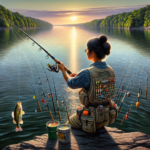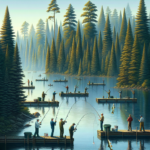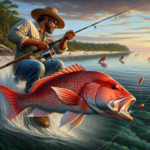Smallmouth Bass Fishing in the Potomac River: Virginia and Maryland

Introduction
Did you know that the Potomac River is one of the premier destinations for smallmouth bass fishing in the United States? Stretching over 400 miles, this river offers a diverse and thriving ecosystem that is perfect for anglers of all skill levels. In this article, we will explore the ins and outs of smallmouth bass fishing in the Potomac River, focusing on the Virginia and Maryland sections. We will cover everything from the best fishing techniques and gear to the top fishing spots and seasonal considerations. Whether you’re a seasoned angler or a beginner, this guide will help you make the most of your fishing experience on the Potomac River.
Why does this matter? Smallmouth bass fishing is not just a hobby; it’s a way to connect with nature, challenge yourself, and enjoy the great outdoors. Knowing where to fish, what techniques to use, and how to prepare can make all the difference in your success and enjoyment. Let’s dive in!
Background/Context
Historical or Cultural Significance
The Potomac River has a rich history that dates back to the early Native American tribes who relied on its waters for sustenance. Over the centuries, it has played a crucial role in the development of the surrounding regions, including Virginia and Maryland. Today, the river is a popular destination for recreational activities, including fishing, boating, and hiking. Smallmouth bass, in particular, have become a prized catch for anglers due to their fighting spirit and the challenge they present.
Geographical Overview
The Potomac River flows from the Appalachian Mountains in West Virginia, through Maryland and Virginia, and eventually empties into the Chesapeake Bay. The river’s diverse ecosystem includes a variety of habitats, from fast-flowing rapids to calm, deep pools. The climate in this region is generally temperate, with hot summers and cold winters, making it an ideal environment for smallmouth bass.
Key Points/Details
Fishing Techniques
Technique Overview
When it comes to smallmouth bass fishing, several techniques can be highly effective. These include:
- Fly Fishing: Using artificial flies to mimic the natural prey of smallmouth bass.
- Spin Fishing: Utilizing spinning reels and a variety of lures such as crankbaits, jigs, and soft plastics.
- Topwater Fishing: Employing lures that float on the surface to attract bass, especially during early morning or late evening.
When and Where to Use
Each technique has its ideal conditions:
- Fly Fishing: Best used in shallow, clear waters where bass are feeding on insects.
- Spin Fishing: Versatile and can be used in various conditions, from fast-moving currents to deep pools.
- Topwater Fishing: Most effective during low-light conditions or when bass are actively feeding near the surface.
Recommended Gear
For a successful smallmouth bass fishing trip, consider the following gear:
- Rods: Medium to medium-heavy action rods, around 6-7 feet in length.
- Reels: Spinning reels with a smooth drag system.
- Lines: 8-12 lb test monofilament or fluorocarbon lines.
- Lures: Crankbaits, jigs, soft plastics, and topwater lures.
Species Information
Species Overview
Smallmouth bass (Micropterus dolomieu) are known for their aggressive behavior and strong fight, making them a favorite among anglers. They prefer clear, cool waters with rocky or sandy bottoms and are often found near structures such as submerged logs, rocks, and ledges. Smallmouth bass are most active during the warmer months, from late spring to early fall.
Best Practices
To increase your chances of catching smallmouth bass, consider the following tips:
- Location: Focus on areas with rocky structures, submerged logs, and ledges.
- Timing: Early morning and late evening are the best times to fish for smallmouth bass.
- Presentation: Use a slow and steady retrieve to mimic the natural movement of prey.
Location Information
Top Fishing Spots
The Potomac River offers numerous excellent fishing spots for smallmouth bass. Some of the top locations include:
- Harpers Ferry: Known for its scenic beauty and abundant smallmouth bass population.
- Great Falls: Offers challenging fishing conditions with fast-moving currents and deep pools.
- Seneca Breaks: A popular spot for both wading and boat fishing, with plenty of rocky structures.
Regulations and Licenses
Before you head out, make sure you are aware of the local fishing regulations and license requirements. In both Virginia and Maryland, anglers need a valid fishing license. Additionally, there are specific regulations regarding catch limits and seasonal restrictions. Always check the latest regulations from the Virginia Department of Wildlife Resources and the Maryland Department of Natural Resources.
Seasonal Considerations
Seasonal Variations
Fishing conditions on the Potomac River can vary significantly throughout the year:
- Spring: As water temperatures rise, smallmouth bass become more active and move into shallower waters to spawn.
- Summer: Bass are most active during early morning and late evening when temperatures are cooler.
- Fall: Bass feed aggressively to prepare for winter, making it an excellent time for fishing.
- Winter: Bass activity slows down, and they move to deeper waters. Fishing can be challenging but still possible.
Best Times to Fish
The optimal times for smallmouth bass fishing on the Potomac River are during the spring and fall months. Early morning and late evening are generally the best times of day to fish, as bass are more active during these periods.
Events and Tournaments
Event Overview
The Potomac River hosts several fishing events and tournaments throughout the year. Some notable events include:
- Potomac River Smallmouth Bass Tournament: Held annually, this tournament attracts anglers from all over the region.
- Local Fishing Derbies: Various local organizations host fishing derbies that are open to anglers of all ages and skill levels.
Preparation Tips
To prepare for a fishing event or tournament, consider the following tips:
- Practice: Spend time practicing your casting and retrieval techniques to improve your accuracy and efficiency.
- Gear Check: Ensure all your gear is in good condition and make any necessary repairs or replacements.
- Strategy: Develop a strategy based on the specific conditions of the event location, including water depth, structure, and current.
Tips and Best Practices
General Tips
Here are some general tips to enhance your smallmouth bass fishing experience on the Potomac River:
- Stay Mobile: Don’t be afraid to move around and try different spots if you’re not having success in one area.
- Observe Nature: Pay attention to the behavior of birds and other wildlife, as they can often indicate the presence of fish.
- Be Patient: Fishing requires patience and persistence. Don’t get discouraged if you don’t catch anything right away.
Avoid Common Mistakes
To avoid common mistakes, keep the following in mind:
- Overcasting: Avoid casting too far, as smallmouth bass are often found near structures close to the shore.
- Ignoring Weather: Weather conditions can significantly impact fishing success. Pay attention to forecasts and plan accordingly.
- Using the Wrong Lures: Match your lures to the natural prey of smallmouth bass in the area.
Advanced Techniques
For more experienced anglers, consider these advanced techniques:
- Drop Shotting: A finesse technique that involves using a weighted hook to present a soft plastic bait just off the bottom.
- Jerkbait Fishing: Using jerkbaits with erratic movements to trigger aggressive strikes from smallmouth bass.
- Swimbait Fishing: Employing larger swimbaits to target bigger bass, especially during the pre-spawn period.
Gear and Equipment Recommendations
Essential Gear
For smallmouth bass fishing on the Potomac River, you’ll need the following essential gear:
- Rod and Reel: Medium to medium-heavy action rod with a spinning reel.
- Line: 8-12 lb test monofilament or fluorocarbon line.
- Lures: Crankbaits, jigs, soft plastics, and topwater lures.
- Tackle Box: A well-organized tackle box with a variety of lures, hooks, and weights.
Optional Gear/Upgrades
Consider these optional gear upgrades to enhance your fishing experience:
- Fish Finder: A fish finder can help you locate schools of bass and identify underwater structures.
- Waders: If you plan to wade in the river, a good pair of waders will keep you dry and comfortable.
- Polarized Sunglasses: Polarized sunglasses reduce glare and help you see fish and underwater structures more clearly.
Where to Buy or Rent
You can purchase or rent fishing gear from local shops such as:
- Bass Pro Shops: Offers a wide range of fishing gear and equipment.
- Cabela’s: Another excellent option for purchasing fishing gear.
- Local Tackle Shops: Support local businesses by purchasing gear from nearby tackle shops.
Safety and Conservation
Safety Tips
When fishing on the Potomac River, keep these safety tips in mind:
- Wear a Life Jacket: Always wear a life jacket when fishing from a boat or wading in deep waters.
- Check Weather Conditions: Be aware of weather forecasts and avoid fishing during severe weather conditions.
- Stay Hydrated: Bring plenty of water and stay hydrated, especially during hot summer days.
Conservation Practices
Practice sustainable fishing to help preserve the Potomac River’s ecosystem:
- Catch and Release: Consider releasing smallmouth bass to help maintain healthy populations.
- Respect Wildlife: Avoid disturbing local wildlife and their habitats.
- Follow Regulations: Adhere to local fishing regulations and catch limits.
Planning Your Trip
Accommodations
If you’re planning an extended fishing trip, consider staying at one of these nearby accommodations:
- Harpers Ferry KOA: Offers camping sites and cabins near Harpers Ferry.
- Great Falls Park Lodging: Various lodging options are available near Great Falls Park.
- Local Hotels: Numerous hotels and motels are available in nearby towns and cities.
Travel Tips
Here are some travel tips to help you get to the Potomac River:
- Driving: The Potomac River is easily accessible by car from major cities like Washington, D.C., and Baltimore.
- Parking: Many fishing spots have designated parking areas. Be sure to check for any parking fees or restrictions.
- Public Transportation: Some areas of the Potomac River are accessible via public transportation, including buses and trains.
Additional Activities
If you’re traveling with family or friends who may not be interested in fishing, consider these additional activities:
- Hiking: The Potomac River offers numerous hiking trails with stunning views.
- Boating: Rent a kayak or canoe and explore the river from a different perspective.
- Historical Sites: Visit nearby historical sites such as Harpers Ferry National Historical Park.
Frequently Asked Questions (FAQs)
Do I need a fishing license to fish on the Potomac River?
Yes, anglers need a valid fishing license to fish on the Potomac River. Be sure to check the specific requirements for Virginia and Maryland.
What is the best time of year to fish for smallmouth bass on the Potomac River?
The best times to fish for smallmouth bass are during the spring and fall months when bass are most active.
What type of lures should I use for smallmouth bass fishing?
Effective lures for smallmouth bass include crankbaits, jigs, soft plastics, and topwater lures.
Are there any fishing tournaments on the Potomac River?
Yes, the Potomac River hosts several fishing tournaments throughout the year, including the Potomac River Smallmouth Bass Tournament.
Can I rent fishing gear near the Potomac River?
Yes, you can rent fishing gear from local tackle shops and outdoor stores near the Potomac River.
Conclusion
In summary, smallmouth bass fishing on the Potomac River offers an exciting and rewarding experience for anglers of all skill levels. By understanding the best fishing techniques, gear, and locations, you can maximize your chances of success. Remember to follow local regulations, practice sustainable fishing, and prioritize safety. Whether you’re planning a day trip or an extended fishing adventure, the Potomac River has something to offer everyone. So grab your gear, head to the river, and enjoy the thrill of smallmouth bass fishing!
How to Use This Template:
- For Location-Based Articles: Emphasize sections on “Top Fishing Spots,” “Regulations,” and “Planning Your Trip.”
- For Species-Specific Articles: Focus on “Species Information,” “Techniques,” and “Gear Recommendations.”
- For Technique-Focused Articles: Prioritize “Fishing Techniques,” “Gear and Equipment,” and “Tips and Best Practices.”
- For Seasonal Content: Highlight “Seasonal Considerations” and adjust the “Techniques” and “Gear” sections to suit the season.
- For Event Coverage: Include detailed information in “Events and Tournaments,” along with “Preparation Tips” and “Gear Recommendations.”
Happy fishing!




